Weber SUMMIT User Manual
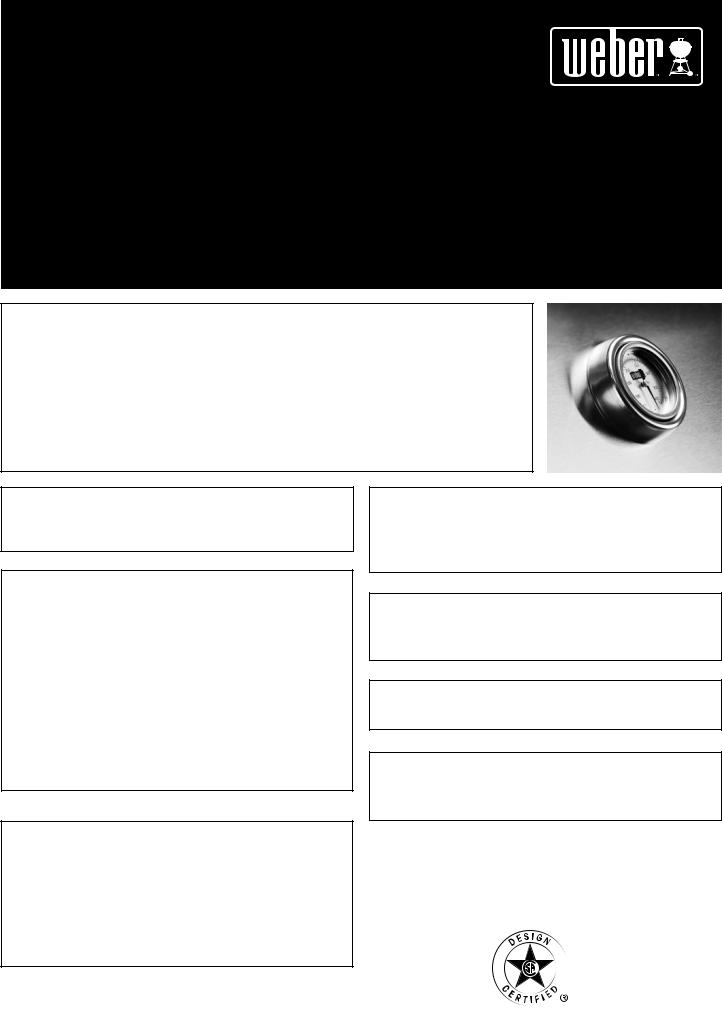
SUMMIT®
GAS GRILL
Natural Gas Grill Owner’s Guide
#38050
YOU MUST READ THIS OWNERS GUIDE BEFORE OPERATING YOUR GASGRILL
DANGER
If you smell gas:
1.Shut off gas to the appliance.
2.Extinguish any open flames.
3.Open lid.
4.If odor continues, keep away from the appliance and immediately call your gas supplier or your fire department.
Leaking gas may cause a fire or explosion which can cause serious bodily injury or death, or damage to property.
WARNING
1.Do not store or use gasoline or other flammable liquids or vapors in the vicinity of this or any other appliance .
2.An LP cylinder not connected for use shall not be stored in the vicinity of this or any other appliance.
WARNING: Follow all leak-check procedures carefully in this manual prior to barbecue operation. Do this even if the barbecue was dealer-assembled.
NOTICE TO INSTALLER: These instructions must be left with the owner and the owner should keep them for future use.
THIS GAS APPLIANCE IS DESIGNED FOR OUTDOOR USE ONLY.
WARNING: Do not try to light this appliance without reading the “Lighting Instructions” section of this manual.
38050 US 03/02/06 NG US ENGLISH
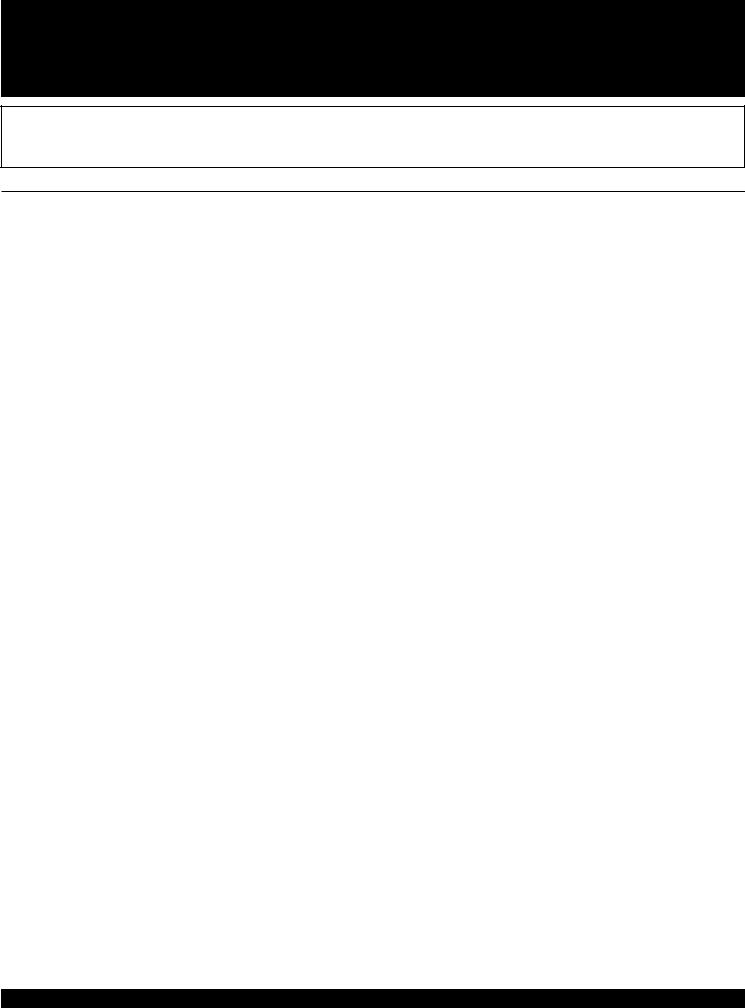
2DANGERS AND WARNINGS
DANGER
Failure to follow the Dangers, Warnings and Cautions contained in this Owner’s Manual may result in serious bodily injury or death, or in a fire or an explosion causing damage to property.
WARNINGS
Do not store a spare or disconnected liquid propane cylinder under or near this barbecue.
Improper assembly may be dangerous. Please follow the assembly instructions carefully.
After a period of storage, and/or nonuse, the Weber® gas barbecue should be checked for gas leaks and burner obstructions before use. See instructions in this manual for correct procedures.
Do not operate the Weber® gas barbecue if there is a gas leak present.
Do not use a flame to check for gas leaks.
Combustible materials should never be within 24 inches of the back or sides of your Weber® gas barbecue.
Do not put a barbecue cover or anything flammable on, or in the storage area under the barbecue.
Your Weber® gas barbecue should never be used by children. Accessible parts of the barbecue may be very hot. Keep young children away while it is in use.
You should exercise reasonable care when operating your Weber® gas barbecue. It will be hot during cooking or cleaning and should never be left unattended, or moved while in operation.
Should the burners go out while in operation, turn all gas valves off. Open the lid and wait five minutes before attempting to relight, using the lighting instructions.
Do not use charcoal or lava rock in your Weber® gas barbecue.
Never lean over open grill or place hands or fingers on the front edge of the cooking box.
Should a grease fire occur, turn off all burners and leave lid closed until fire is out.
Do not enlarge valve orifices or burner ports when cleaning the valves or burners.
The Weber® gas barbecue should be thoroughly cleaned on a regular basis.
Liquid propane gas is not natural gas. The conversion or attempted use of natural gas in a liquid propane unit or liquid propane gas in a natural gas unit is dangerous and will void your warranty.
Do not attempt to disconnect any gas fitting while your barbecue is in operation.
Use heat-resistant barbecue mitts or gloves when operating barbecue.
Keep any electrical supply cord and the fuel supply hose away from any heated surfaces.
Combustion byproducts produced when using this product contain chemicals known to the state of California to cause cancer, birth defects, or other reproductive harm.
Do not use this barbecue unless all parts are in place. The unit must be properly assembled according to the instructions outlined in the “Assembly Instructions”.
LIQUID PROPANE GAS UNITS ONLY:
Use the pressure regulator and hose assembly that is supplied with your Weber® gas barbecue.
Do not attempt to disconnect the gas regulator and hose assembly or any gas fitting while your barbecue is in operation.
A dented or rusty liquid propane cylinder may be hazardous and should be checked by your liquid propane supplier. Do not use a liquid propane cylinder with a damaged valve.
Although your liquid propane cylinder may appear to be empty, gas may still be present, and the cylinder should be transported and stored accordingly.
If you see, smell or hear the hiss of escaping gas from the liquid propane cylinder:
1.Move away from liquid propane cylinder.
2.Do not attempt to correct the problem yourself.
3.Call your fire department.
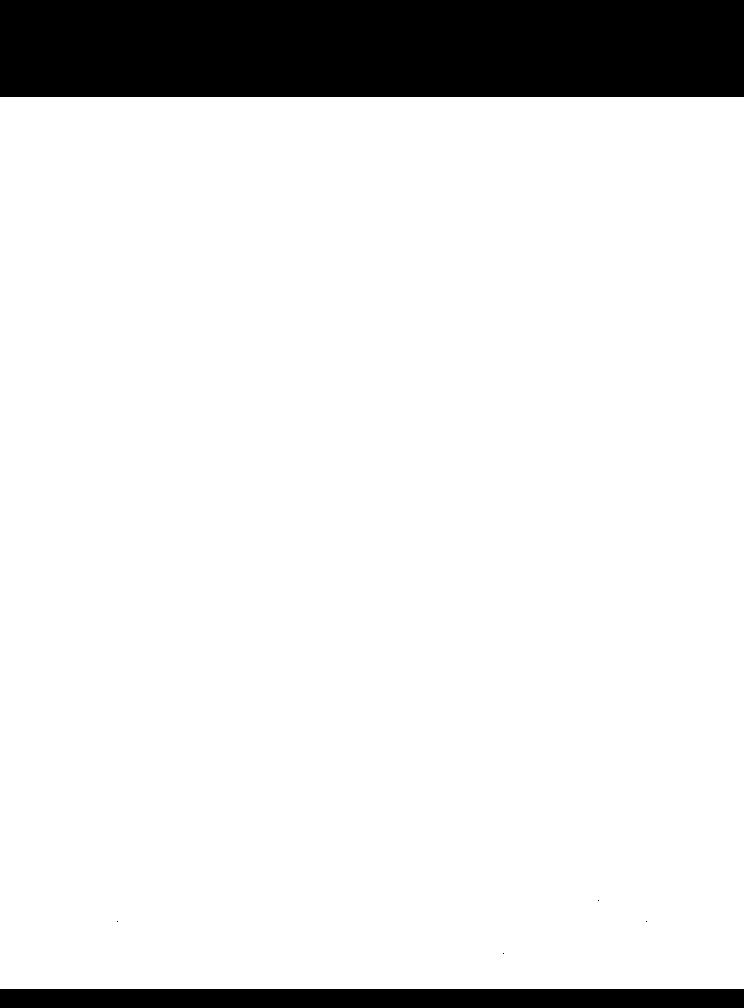
WARRANTY 3
Weber-Stephen Products Co. (Weber) hereby warrants to the ORIGINAL PURCHASER of this Weber® gas grill that it will be free of defects in material and workmanship from the date of purchase as follows:
Aluminum Castings, lifetime, 1 year paint Stainless Steel Hood Section, 25 years
Porcelain Hood Section, 25 years Burners, 10 years
Igniter, 3 years Porcelain Enameled
Cooking Grates, 3 years no rust through
Porcelain Enameled Cast Iron
Cooking Grates, 5 years no rust through
Stainless Steel Cooking Grates, 7 years no rust through
Porcelain Enameled
Flavorizer® Bars, 1 year no rust through
Stainless Steel
Flavorizer® Bars, 5 year no rust through
Thermoplastic/Thermoset Parts, 10 years Excluding fading
Rotisserie and all related components, 1 year
All Remaining Parts, 5 years
when assembled and operated in accordance with the printed instructions accompanying it.
Weber may require reasonable proof of your date of purchase. THEREFORE, YOU SHOULD RETAIN YOUR SALES SLIP OR INVOICE.
This Limited Warranty shall be limited to the repair or replacement of parts that prove defective under normal use and service and which on examination shall indicate, to Weber’s satisfaction, they are defective. Before returning any parts, contact the Customer Service Representative in your area using the contact information on our website. If Weber confi rms the defect and approves the claim, Weber will elect to replace such parts without charge.
If you are required to return defective parts, transportation charges must be prepaid. Weber will return parts to the purchaser, freight or postage prepaid.
This Limited Warranty does not cover any failures or operating diffi culties due to accident, abuse, misuse, alteration, misapplication, vandalism, improper installation or improper maintenance or service, or failure to perform normal and routine maintenance, including but not limited to damage caused by insects within the burner tubes, as set out in this owner’s manual.
Deterioration or damage due to severe weather conditions such as hail, hurricanes, earthquakes or tornadoes, discoloration due to exposure to chemicals either directly or in the atmosphere, is not covered by this Limited Warranty.
There are no other express warrants except as set forth herein and any applicable implied warranties of merchantability and fi tness are limited in duration to the period of coverage of this express written Limited Warranty. Some regions do not allow limitation on how long an implied warranty lasts, so this limitation may not apply to you.
Weber is not liable for any special, indirect or consequential damages. Some regions do not allow the exclusion or limitation of incidental or consequential damages, so this limitation or exclusion may not apply to you.
Weber does not authorize any person or company to assume for it any other obligation or liability in connection with the sale, installation, use, removal, return, or replacement of its equipment; and no such representations are binding on Weber.
This Warranty applies only to products sold at retail.
WEBER-STEPHEN PRODUCTS CO.
Customer Service Center
1890 Roselle Road, Suite 308
Schaumburg, IL 60195
USA
For replacement parts call:
1-800-446-1071 www.weber.com®
©2006 The following trademarks are registered in the name of Weber-Stephen Products Co., an Illinois corporation, located at 200 East Daniels Road, Palatine, Illinois 60067 U.S.A. Australia; Smokey Joe, Weber, Kettle Silhouette , Genesis, Austria; Kettle Silhouette
, Genesis, Austria; Kettle Silhouette , Smokey Joe, Weber, Benelux; Kettle Silhouette
, Smokey Joe, Weber, Benelux; Kettle Silhouette , Smokey Joe, Weber, Compact Grill Configuration, Botswana; Weber, Canada; Smokey Joe, Genesis, China; Kettle Silhouette
, Smokey Joe, Weber, Compact Grill Configuration, Botswana; Weber, Canada; Smokey Joe, Genesis, China; Kettle Silhouette , Denmark; Kettle Silhouette
, Denmark; Kettle Silhouette , Smokey Joe, Weber, Finland; Smokey Joe, France; Kettle Silhouette
, Smokey Joe, Weber, Finland; Smokey Joe, France; Kettle Silhouette , Smokey Joe, Weber, One-Touch, Germany; Smokey Joe, Weber, One-Touch, Greece; Smokey Joe, Ireland; Kettle Silhouette
, Smokey Joe, Weber, One-Touch, Germany; Smokey Joe, Weber, One-Touch, Greece; Smokey Joe, Ireland; Kettle Silhouette , Smokey Joe, Italy; Smokey Joe, Weber, Japan; Smokey Joe, Weber, Korea; Smokey Joe, Weber, New Zealand; Weber, Smokey Joe, Nigeria; Weber, Norway; Smokey Joe, Weber, Portugal; Weber, South Africa: Smokey Joe, Weber, Kettle Configuration, Spain; Smokey Joe, Weber, Sweden; Kettle Silhouette
, Smokey Joe, Italy; Smokey Joe, Weber, Japan; Smokey Joe, Weber, Korea; Smokey Joe, Weber, New Zealand; Weber, Smokey Joe, Nigeria; Weber, Norway; Smokey Joe, Weber, Portugal; Weber, South Africa: Smokey Joe, Weber, Kettle Configuration, Spain; Smokey Joe, Weber, Sweden; Kettle Silhouette , Smokey Joe, Switzerland; Kettle Silhouette
, Smokey Joe, Switzerland; Kettle Silhouette , Smokey Joe, Weber, United Kingdom; Smokey Joe, Weber, Weber One-Touch, U.S.A..; Kettle Configuration, Kettle Silhouette
, Smokey Joe, Weber, United Kingdom; Smokey Joe, Weber, Weber One-Touch, U.S.A..; Kettle Configuration, Kettle Silhouette , Smokey Joe, Weber, One-Touch, Firespice, Go-Any- where, U.S.A.;Kettle Configuration, Kettle Silhouette, Genesis, Flavorizer, Crossover, Flamgo, Performer, Rapidfi re, Tuck ‘N Carry, Jumbo Joe, Bar-B-Kettle, Master-Touch, Spirit, Grill Out, Summit, Platinum, 1-800-Grill-Out, Ranch, Matchless Flame, Zimbabwe; Weber, Kettle Confi guration, Kettle Silhouette
, Smokey Joe, Weber, One-Touch, Firespice, Go-Any- where, U.S.A.;Kettle Configuration, Kettle Silhouette, Genesis, Flavorizer, Crossover, Flamgo, Performer, Rapidfi re, Tuck ‘N Carry, Jumbo Joe, Bar-B-Kettle, Master-Touch, Spirit, Grill Out, Summit, Platinum, 1-800-Grill-Out, Ranch, Matchless Flame, Zimbabwe; Weber, Kettle Confi guration, Kettle Silhouette . Printed in USA.
. Printed in USA.

4GENERAL INSTRUCTIONS
Your Weber® gas barbecue is a portable outdoor cooking appliance. With the Weber® gas barbecue you can grill, barbecue, roast and bake with results that are diffi cult to duplicate with indoor kitchen appliances. The closed lid and Flavorizer® bars produce that “outdoor” fl avor in the food.
The Weber® gas barbecue is portable so you can easily change its location in your yard or on your patio. Portability means you can take your Weber® gas barbecue with you if you move.
The natural gas supply is easy to use and gives you more cooking control than charcoal fuel.
•These instructions will give you the minimum requirements for assembling your Weber® gas barbecue. Please read the instructions carefully before using your Weber® gas barbecue. Improper assembly can be dangerous.
•Not for use by children.
•If there are local codes that apply to portable gas grills, you will have to conform to them. If there are no local codes, you must conform to the latest edition of the National Fuel Gas Code: ANSI Z 223.1/NFPA 54, or CAN/CGA-B149.1, Natural Gas and Propane Installation Code.
•This Weber® gas barbecue is designed for natural (piped in city) gas only. Do not use liquid propane (LP) bottled gas. The valves, orifi ces and hose are for natural gas only.
•Do not use with charcoal fuel.
•Check that the area under the control panel and the bottom tray are free from debris that might obstruct the fl ow of combustion or ventilation air.
FOR INSTALLATION IN CANADA
These instructions, while generally acceptable, do not necessarily comply with the Canadian Installation codes, particularly with piping above and below ground. In Canada the installation of this appliance must comply with local codes and/or Standards CAN/CGA-B149.1 (Installation Code for Natural Gas Burning Appliances and Equipment).
OPERATING
WARNING: Only use this barbecue outdoors in a wellventilated area. Do not use in a garage, building, breezeway or any other enclosed area.
WARNING: Your Weber® gas barbecue shall not be used under overhead combustible construction.
WARNING: Your Weber® gas barbecue is not intended to be installed in or on recreational vehicles and/or boats.
WARNING: Do not use the barbecue within 24 inches of combustible materials, top, bottom, back or sides of the grill.
WARNING: The entire cooking box gets hot when in use. Do not leave unattended.
WARNING: Keep any electrical supply cord and the fuel supply hose away from any heated surface.
WARNING: Keep the cooking area clear of flammable vapors and liquids, such as gasoline, alcohol, etc., and combustible materials.
Gas Supply Testing
•Disconnect your Weber® gas barbecue when the gas supply is being tested at high pressures. This appliance and its individual shutoff valve must be disconnected from the gas supply piping system during any pressure testing of that system at test pressures in excess of 1/2 psig (3.5 kPa).
•Turn OFF your Weber® gas barbecue when the gas supply is being tested at low pressures. This appliance must be isolated from the gas supply piping system by closing its individual manual shutoff valve during any pressure testing of the gas supply piping system at the pressure equal to or less than 1/2 psig (3.5 kPa).
STORAGE
•The gas must be turned OFF at the natural gas supply when the
Weber® gas barbecue is not in use.
•When the Weber® gas barbecue is stored indoors, the gas supply must be disconnected.
•The Weber® gas barbecue should be checked for gas leaks and any obstructions in the burner tubes before using. (See Sections: “General
Maintenance and Annual Maintenance.”)
•Check that the areas under the control panel and the slide out bottom tray are free from debris that might obstruct the fl ow of combustion or ventilation air.
•The Spider /Insect Screens should also be checked for any obstructions. (See Section: "Annual Maintenance.")

GENERAL INSTRUCTIONS |
5 |
|
|
|
|
GRILLING METHODS
NOTE: If grill looses heat while cooking refer to the troubleshooting section of this manual.
WARNING: Do not move the Weber® gas barbecue when operating or while barbecue is hot.
You can adjust the Left and Right burners in each burner set as desired. The control settings are High (H), Medium (M), Low (L), or Off (O).
Note: The temperature inside your cooking box for the first few uses, while surfaces are still very reflective, may be hotter than those shown in your cookbook. Cooking conditions. Such as wind and weather, may require the adjustment of the burner controls to obtain the correct cooking temperatures.
If burners go out during cooking, open lid, turn off all burners and wait five minutes before relighting.
Preheating - Your Weber® gas barbecue is an energy-effi cient appliance. It operates at an economical low BTU rate. To preheat: after lighting, close lid and turn all burners to high (HH). Preheating to between 500° and 550° F (260° and 290° C) will take 10 to 15 minutes depending on conditions such as air temperature and wind.
Drippings and grease - The Flavorizer® bars are designed to “smoke” the correct amount of drippings for fl avorful cooking. Excess drippings and grease will accumulate in the catch pan under the slide out bottom tray.
Disposable foil drip pans are available that fi t the catch pan.
WARNING: Check the bottom tray for grease build-up before each use. Remove excess grease to avoid a grease fire in the slide out bottom tray.
CLEANING
WARNING: Turn your Weber® gas barbecue OFF and wait for it to cool before cleaning.
CAUTION: Do not clean your Flavorizer® bars or
cooking grates in a self-cleaning oven.
For availability of replacement cooking grates and Flavorizer® bars contact the Customer Service Representative in your area using the contact information on our website. Log onto www.weber.com®
Outside surfaces - Use a warm soapy water solution to clean, then rinse with water.
CAUTION: Do not use oven cleaner, abrasive cleansers (kitchen cleansers) cleaners that contain citrus products, or abrasive cleaning pads on barbecue or cart surfaces.
Slide out Bottom tray - Remove excess grease, then wash with warm soapy water, then rinse
Flavorizer® bars and Cooking grates - Clean with a suitable brass bristle brush. As needed, remove from grill and wash with warm soapy water, then rinse with water.
Catch pan - Disposable foil trays are available, or you can line the catch pan with aluminum foil. To clean the catch pan, wash with warm soapy water, then rinse.
Thermometer - Wipe with warm soapy water; clean with plastic scrub ball.
Inside cooking module - Brush any debris off of burner tubes. DO NOT ENLARGE BURNER PORTS (OPENINGS). Wash inside of cooking box with warm soapy water and a water rinse.
Inside Lid - While lid is warm, wipe inside with paper towel to prevent grease build-up. Flaking built-up grease resembles paint fl akes.
Stainless steel surfaces - Wash with a soft cloth and a soap and water solution. Be careful to scrub with the grain direction of the stainless steel.
Thermoset surfaces - Wash with a soft cloth and a soap and water solution.
Do not use cleaners that contain acid, mineral spirits or xylene. Rinse well after cleaning.
Thermoset work surfaces are not to be used as cutting boards.
Preserve Your Stainless Steel
Your grill or its cabinet, lid, control panel and shelves may be made from stainless steel. To keep the stainless steel looking its best is a simple matter. Clean it with soap and water, rinse with clear water and wipe dry. For stubborn particles, the use of anon-metallic brush can be used.
IMPORTANT: Do not use a wire brush or abrasive cleaners on the stainless steel surfaces of your grill as this will cause scratches.
IMPORTANT: When cleaning surfaces be sure to rub/ wipe in the direction of the grain to preserve the look of your stainless steel.
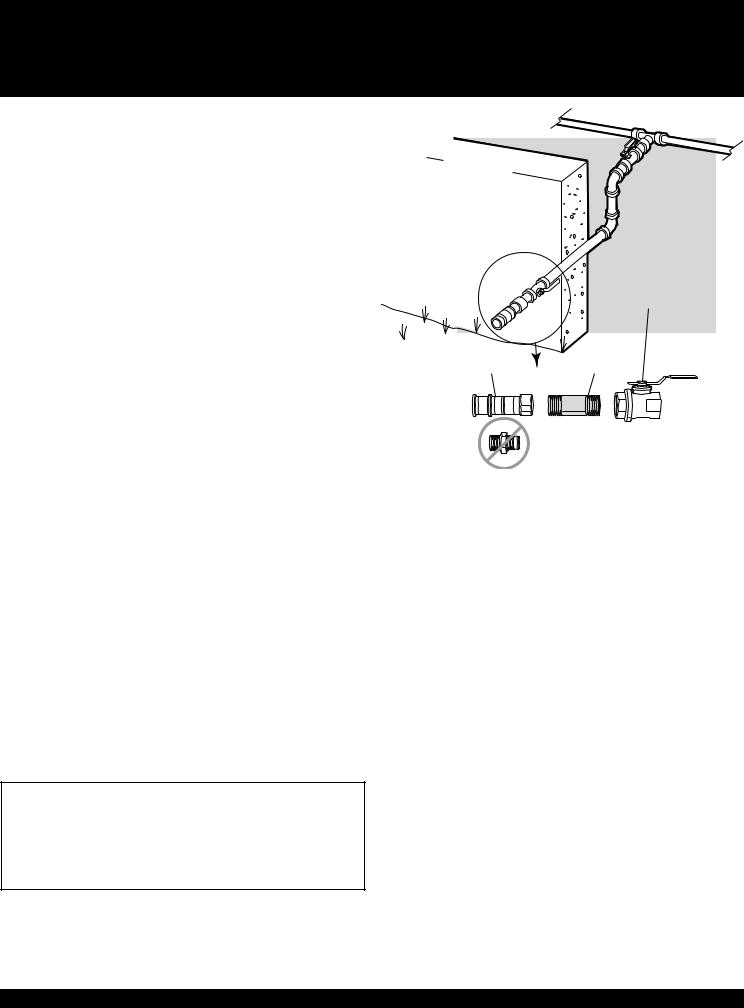
6 |
GAS INSTRUCTIONS |
|
INSTALL GAS SUPPLY
General Specifications for Piping
Note - Contact your local municipality for building codes regulating outdoor gas barbecue installations. In absence of Local Codes, you must confirm to the latest edition of the National Fuel Gas Code: ANSI Z
223.1/NFPA 54, or CAN/CGA-B149.1, Natural Gas and Propane Installation Code. WE RECOMMEND THAT THIS INSTALLATION BE DONE BY A
PROFESSIONAL.
Some of the following are general requirements taken from the latest edition of the National Fuel Gas Code: ANSI Z 223.1/NFPA 54, or CAN/
CGA-B149.1, Natural Gas and Propane Installation Code for complete specifi cations.
•This barbecue is designed to operate at 4.5 inches of water column pressure (.16241 psi).
A manual shut-off valve must be installed outdoors, immediately ahead of the quick disconnect.
•An additional manual shut-off valve indoors should be installed in the branch fuel line in an accessible location near the supply line
•The quick disconnect connects to a 1/2 inch NPT thread from the gas source. The quick disconnect fi tting is a hand-operated device that automatically shuts OFF the fl ow of gas from the source when the barbecue is disconnected
•The quick disconnect fi tting can be installed horizontally, or pointing downward. Installing the fi tting with the open end pointing upward can result in collecting water and debris.
•The dust covers (supplied plastic plugs) help keep the open ends of the quick disconnect fi tting clean while disconnected.
•Pipe compound should be used which is resistant to the action of natural gas when connections are made.
•The outdoor connector must be fi rmly attached to rigid, permanent construction.
WARNING: Do not route the 10 foot hose under a deck. The hose must be visible.
Gas Line Piping
•If the length of the line required does not exceed 50 feet, use a 5/8" O.D. tube. One size larger should be used for lengths greater than 50 feet.
•Gas piping may be copper tubing, type K or L; polyethylene plastic tube, with a minimum wall thickness of .062 inch; or standard weight (schedule
40) steel or wrought iron pipe.
•Copper tubing must be tin-lined if the gas contains more than 0.3 grams of hydrogen sulfi de per 100 cubic feet of gas.
•Plastic tubing is suitable only for outdoor, underground use.
•Gas piping in contact with earth, or any other material which may corrode the piping, must be protected against corrosion in an approved manner.
•Underground piping must have a minimum of 18" cover
Test Connections
All connections and joints must be thoroughly tested for leaks in accordance with local codes and all listed procedures in the latest edition of the National Fuel Gas Code: ANSI Z 223.1/NFPA 54, or CAN/CGA-B149.1
DANGER
Do not use an open flame to check for gas leaks. Be sure there are no sparks or open flames in the area while you check for gas leaks. This will result in a fire or explosion which can cause serious bodily injury or death and damage to property.
Gas supply
Inside wall
Outside wall
Shut off
This is a typical installation of a Weber® natural gas barbecue. Local codes may require different installations.
Locking shut off
Quick |
1/ " Pipe |
disconnect |
2 |
nipple |
Do Not Use
LEAK CHECK PREPARATION
CHECK THAT ALL BURNER VALVES ARE OFF
Valves are shipped in the OFF position, but you should check to be sure that they are turned OFF. Check by pushing down and turning clockwise. If they do not turn, they are off. Proceed to the next step. If they do turn continue turning them clockwise until they stop, then they are off. Proceed to the next step.
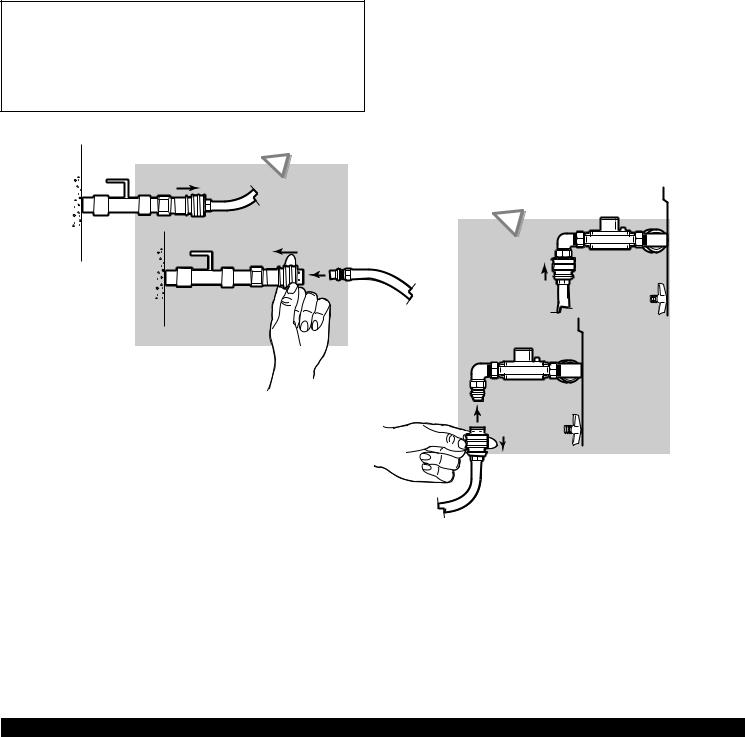
GAS INSTRUCTIONS |
7 |
|
|
|
|
CONNECT GAS SUPPLY
a)To connect gas hose supply: Slide back the collar of the quick disconnect. Push male fi tting of the hose into the quick disconnect, and maintain pressure(1). Slide the collar closed(2). If it does not engage or lock, repeat procedure.
b)To connect gas hose at the Grill: Slide back the collar of the quick disconnect. Push male fi tting of the hose into the quick disconnect, and maintain pressure(1). Slide the collar closed(2). If it does not engage or lock, repeat procedure.
Gas will not fl ow unless the quick disconnect is properly engaged.
Check for Gas Leaks
WARNING: You should check for gas leaks every time you disconnect and reconnect a gas fitting.
WARNING: Perform these leak checks even if your barbecue was dealer or store assembled.
Turn on gas supply.
Check for leaks by wetting the connections with the soap and water solution and watching for bubbles. If bubbles form or if a bubble grows, there is a leak.
Note - Since some leak test solutions, including soap and water, may be slightly corrosive, all connections should be rinsed with water after checking for leaks.
DANGER:
Do not use an open flame to check for gas leaks. Be sure there are no sparks or open flames in the area while you check for leaks. Sparks or flames will result in a fire or explosion which can cause serious bodily injury or death and damage to property.
WARNING: Do not ignite burners when leak checking.
a
(2)
b
(1)
(2)
(1)
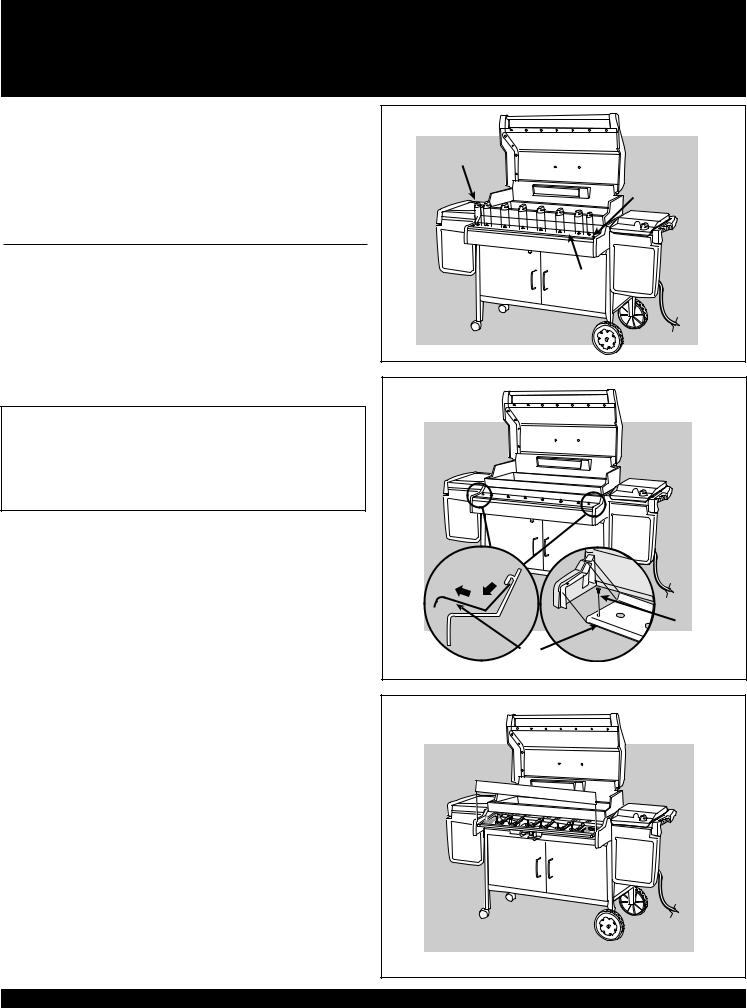
8 |
GAS INSTRUCTIONS |
||
|
|||
CHECK FOR GAS LEAKS |
|
|
|
WARNING : The gas connections of your Summit® |
(1 ) |
||
gas grill have been factory tested. We do however |
|
||
recommend that you leak check all gas connections |
(2 ) |
||
before operating your Summit® gas grill. |
|||
|
|||
REMOVE CONTROL PANEL
Part required: Phillips Screwdriver.
Remove the burner control knobs (1). The screws (2) need to be removed (3 ) from the control panel (3) before the control panel is removed from the grill.
Put your fi ngers under the front edge of the control panel and lift off. Completely remove the control panel (4) from the cooking box assembly exposing the valves, burners, igniter, and manifold.
Remove the Front Panel by sliding the panel up and out of the slots.
CHECK FOR GAS LEAKS
DANGER
Do not use an open flame to check for gas leaks. Be sure there are no sparks or open flames in the area while you check for leaks. Sparks or open flames will result in a fire or explosion which can cause serious bodily injury or death and damage to property.
WARNING: You should check for gas leaks every time you disconnect and reconnect a gas fitting.
Note - All factory-made connections have been thoroughly checked for gas leaks. The burners have been flame-tested. As a safety precaution however, you should recheck all fittings for leaks before using your Weber® gas barbecue. Shipping and handling may loosen or damage a gas fitting.
WARNING: Perform these leak checks even if your |
(2 |
barbecue was dealer or store assembled. |
|
You will need: a soap and water solution, and a rag or brush to apply it. |
(4 ) |
Make sure side burner is OFF (See LEAK CHECK PREPARATION). Remove |
|
valve control knob and screws. Remove porcelain top. |
|
To perform leak checks: Slide back the collar of the quick disconnect. Push |
|
male fi tting of the hose into the quick disconnect, and maintain pressure. |
|
Slide the collar closed. If it does not engage or lock, repeat procedure. Gas |
|
will not fl ow unless the quick disconnect is properly engaged. |
|
Turn on gas supply. |
|
Check for leaks by wetting the connections with the soap and water solution |
|
and watching for bubbles. If bubbles form or if a bubble grows, there is a |
|
leak. |
|
Note - Since some leak test solutions, including soap and water, may be |
|
slightly corrosive, all connections should be rinsed with water after checking |
|
for leaks. |
|
WARNING: Do not ignite burners when leak checking.
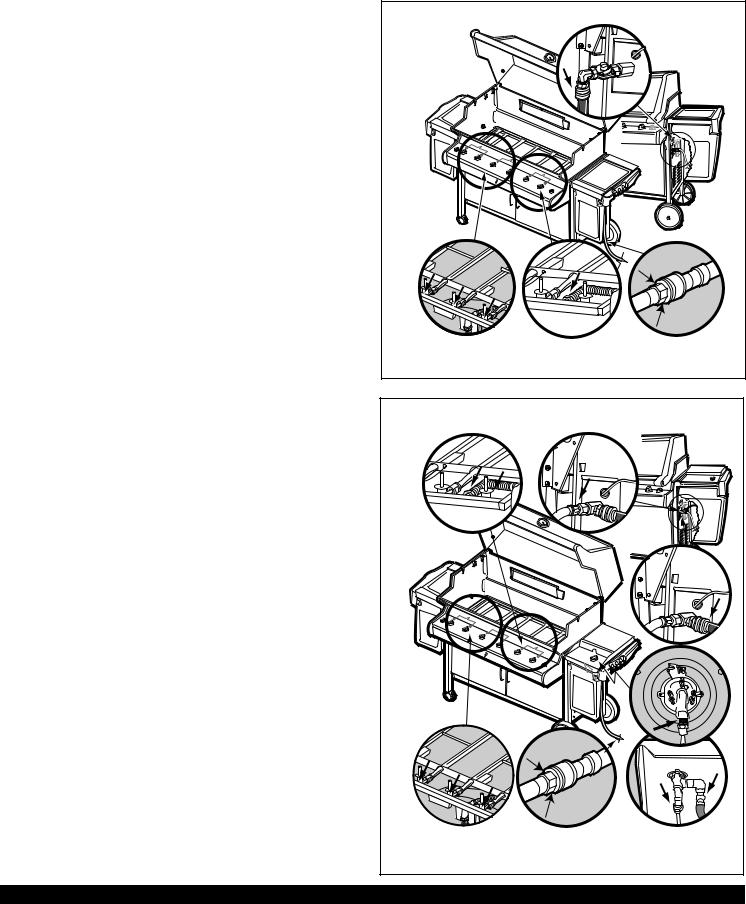
GAS INSTRUCTIONS |
9 |
|
|
|
|
Check:
1)Quick disconnect hose to grill connection
2)Valve to manifold connection
3)Hose to quick disconnect connection (gas supply)
WARNING: If there is a leak at connections (1), (2), or (3) turn OFF the gas. DO NOT OPERATE THE GRILL. Contact the Customer Service Representative in your area using the contact information on our web site. Log onto www.weber.com®.
When leak checks are complete, turn gas supply OFF at the source and rinse connections with water.
4)Gas line to manifold connections.
WARNING: If there is a leak at connection (4), retighten the fitting with a wrench and recheck for leaks with soap and water solution. If a leak persists after retightening the fitting, turn OFF the gas. DO NOT OPERATE THE GRILL. Contact the Customer Service Representative in your area using the contact information on our web site. Log onto www.weber.com®.
Check:
1)Quick disconnect hose to grill connection
2)Side burner hose to manifold connection
3)Side burner hose to side burner connection, and sideburner valve to orifi ce.
4)Hose to quick disconnect connection (gas supply)
5)Valve to manifold connection
WARNING: If there is a leak at connections(1),(2),(3) ,(4), or(5), turn OFF the gas. DO NOT OPERATE THE GRILL. Contact the Customer Service Representative in your area using the contact information on our web
site. Log onto www.weber.com®.
6)Gas line to manifold connections.
7)I.R. Burner gas line connection.
WARNING: If there is a leak at connection (6) or(7) retighten the fitting with a wrench and recheck for leaks with soap and water solution.
If a leak persists after retightening the fitting, turn OFF the gas. DO NOT OPERATE THE GRILL. Contact the Customer Service Representative in your area using the contact information on our web site. Log
onto www.weber.com®.
When leak checks are complete, turn gas supply OFF at the source and rinse connections with water.
SUMMIT® A
)
(2 ) |
(3 ) |
|
(4 )
*The grill illustrated may have slight differences than the model purchased.
SUMMIT® B, D
(6) |
(4) |
|
(7) |
(4)
(5)
(1)
*The grill illustrated may have slight differences than the model purchased.
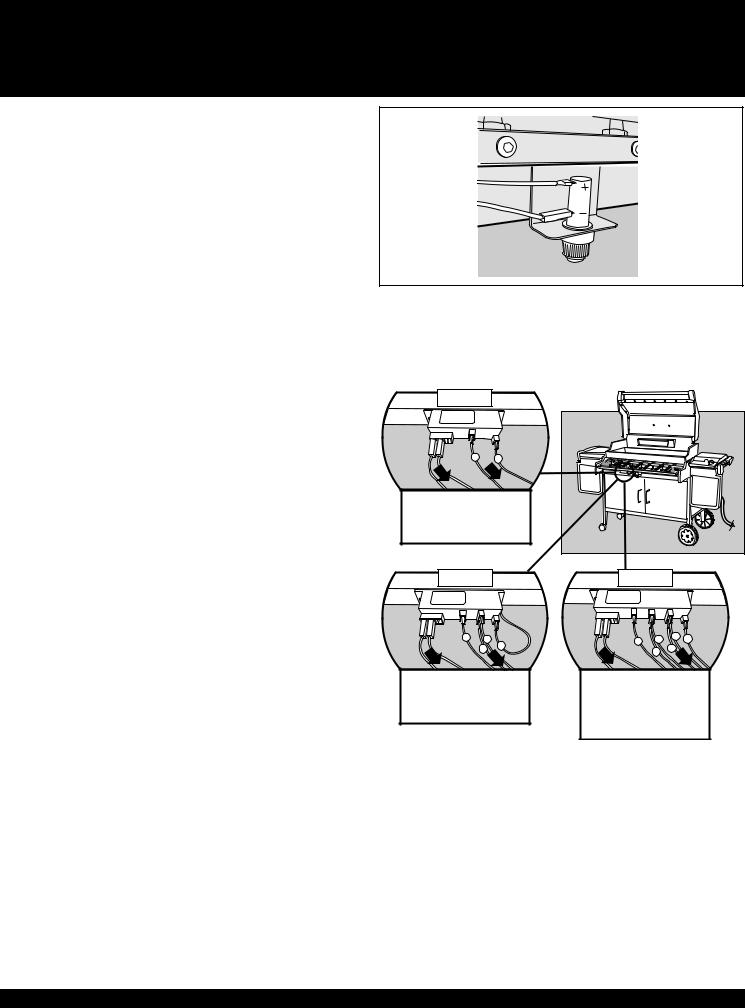
10 |
GAS INSTRUCTIONS |
|
REINSTALL CONTROL PANEL
Parts required: control panel, screws, and burner control knobs.
Place the control panel back onto the control panel brackets on either side of the front of the cooking box.
Line up screws with screw holes on both the control panel and control panel brackets. Tighten screws.
Reinstall burner control knobs & igniter wires (if necessary).
Place corresponding control knobs down onto the valve stems. From the underside of the control panel, replace the two wires (1,2) of each igniter.
GRILLING METHODS
NOTE: If grill looses heat while cooking refer to the troubleshooting section of this manual.
You can adjust the Left and Right burners in each burner set as desired.
The control settings are High (H), Medium (M), Low (L), or Off (O).
If burners go out during cooking, turn off all burners and wait 5 minutes before relighting.
WARNING: Check the bottom tray and catch pan for grease build-up before each use. Remove excess grease to avoid a grease fire in the bottom tray.
Preheating
Preheating the grill before grilling is important. Light your Summit® gas grill according to the instructions in this Owner’s Manual. Turn both burners in each burner set to High (HH), close the lid, and preheat grill with the lid down until grill thermometer reaches 550ºF (260˚-288˚C).This is the recommended broiling temperature. This will take approximately 10 to
15 minutes, depending on outside temperatures.
Covered cooking
All grilling is done with the lid down to provide uniform, evenly circulated heat. With the lid closed, the Summit® gas grill cooks much like a convection oven. The thermometer in the lid indicates the cooking temperature inside the grill. All preheating and grilling is done with the lid down. No peeking — heat is lost every time you lift the lid.
Flavorizer® system
When meat juices drip from the food onto the specially angled Flavorizer® bars, they create smoke that gives foods an irresistible barbecued fl avor.
Thanks to the unique design of the burners, Flavorizer® bars and the fl exible temperature controls, uncontrolled fl are-ups are virtually eliminated, because YOU control the fl ames. Because of the special design of the Flavorizer® bars and burners, excess fats are directed through the funnel-shaped bottom tray into the grease catch pan.
(1)
(2)
Gold A4
- |
+ |
- |
+ |
a b
a = Yellow Tab with Black Wire b = White Tab with Black Wire
Gold B4
- |
+ |
- |
+ |
a |
c |
d |
|
b |
|
|
|
a = Yellow Tab with Black Wire b = White Tab with Black Wire c = Solid White Wire
d = Grounding Wire
Gold D4
|
- |
+ |
|
|
|
- |
+ |
|
|
|
|
a |
c e f |
|
|
|
|
b |
d |
|
|
|
|
|
a |
= |
Blue Tab with Black Wire |
||
b |
= |
Yellow Tab with Black Wire |
||
c |
= |
White Tab with Black Wire |
||
d |
= |
Solid White Wire |
||
e |
= |
Solid Blue Wire |
|
|
f |
= |
Grounding Wire |
|
|
